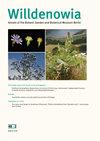A revision of the “basal-axile placentation clade” of Miconieae, the newly erected Miconia sect. Liogieria (Melastomataceae: Miconieae) from the Greater Antilles
IF 1.4
3区 生物学
Q2 PLANT SCIENCES
引用次数: 0
Abstract
Abstract: Phylogenetic analyses show that a group of species of Miconia (Melastomataceae: Miconieae) from the Greater Antilles all form a clade. They share the presence of backward-deflexed filaments with the entire androecium turning pink to red after anthesis and placentation reduced axile to basal. Additionally, many of these species are deciduous, and have fruits with few and relatively large seeds. These species have until recently been recognized in Calycogonium, Miconia, Ossaea and Pachyanthus. The group is composed of 14 species, two from Puerto Rico and 12 from Cuba, including the newly described M. matosiana. We formally describe this clade as M. sect. Liogieria and provide a revision of its species, including an identification key, descriptions, maps and photographs or illustrations for all of them. Twelve names are typified: Calycogonium clidemioides Griseb., C. rosmarinifolium Griseb., Charianthus obliquus Griseb., Graffenrieda obtusa Griseb., Miconia baracoensis Urb., M. cerasiflora Urb., M. cerasiflora var. setulifera Urb., M. confusa Cogn., M. obtusa f. glabrior Urb., M. pachyphylla Cogn., M. thomasiana DC. and M. vernicosa Naudin. Citation: Bécquer E. R., Bochorny T., Gavrutenko M. & Michelangeli F. A. 2022: A revision of the “basal-axile placentation clade” of Miconieae the newly erected Miconia sect. Liogieria (Melastomataceae: Miconieae) from the Greater Antilles. – Willdenowia 52: 387–432. Version of record first published online on 31 December 2022 ahead of inclusion in December 2022 issue.对大安的列斯群岛新建立的Miconieae组miconieia的“基底-轴发育分支”的修正
摘要/ Abstract摘要:系统发育分析表明,来自大安的列斯群岛的一群Miconia (melanastomataceae: Miconieae)属植物均形成一个分支。它们都有向后弯曲的花丝,整个雄蕊在花期和着床后变成粉红色到红色,减少轴到基部。此外,这些物种中的许多是落叶的,果实的种子很少,而且相对较大。这些物种直到最近才在Calycogonium, Miconia, Ossaea和Pachyanthus中被确认。该组由14个物种组成,两个来自波多黎各,12个来自古巴,包括新发现的M. matosiana。我们正式将该分支命名为M. sect. Liogieria,并提供了其物种的修订,包括识别密钥,描述,地图和所有它们的照片或插图。有12个典型的名字:Calycogonium clidemioides Griseb。, C.迷迭香。斜凤仙花;格里塞布,格里塞布。云杉(Miconia baracoensis)紫花蓟马;,石楠花变种。康恩先生。, M. obtusa f. glabrior;M.厚叶菌。, M. thomasiana DC。和vernicosa Naudin先生。引用本文:b cquer E. R., Bochorny T., Gavrutenko M. & Michelangeli F. A. 2022:对大安的列斯群岛新建立的Miconieae科miconieia (Melastomataceae: Miconieae)的“基底-轴发育分支”的修订。——《野生动物学报》52:387-432。记录版本于2022年12月31日首次在线发布,并将于2022年12月发行。
本文章由计算机程序翻译,如有差异,请以英文原文为准。
求助全文
约1分钟内获得全文
求助全文
来源期刊

Willdenowia
PLANT SCIENCES-
CiteScore
4.60
自引率
5.30%
发文量
17
审稿时长
>12 weeks
期刊介绍:
Willdenowia is an international peer-reviewed journal publishing original research articles in English from the entire fields of plant, algal and fungal systematics, covering the evolution, taxonomy and nomenclature of these organisms as well as related fields such as floristics and plant geography. Articles on phylogeny and molecular systematics are especially welcome, as are review articles. Descriptions of new taxa may be considered, but only if supported by robust evidence. Narrowly regional studies of widespread taxa, routine typifications, checklists and new floristic records are generally not considered (excluding contributions to the Euro+Med-Checklist Notulae). Authors are encouraged to deposit duplicates of their material, especially nomenclatural types, in the Berlin herbarium (B).
 求助内容:
求助内容: 应助结果提醒方式:
应助结果提醒方式:


